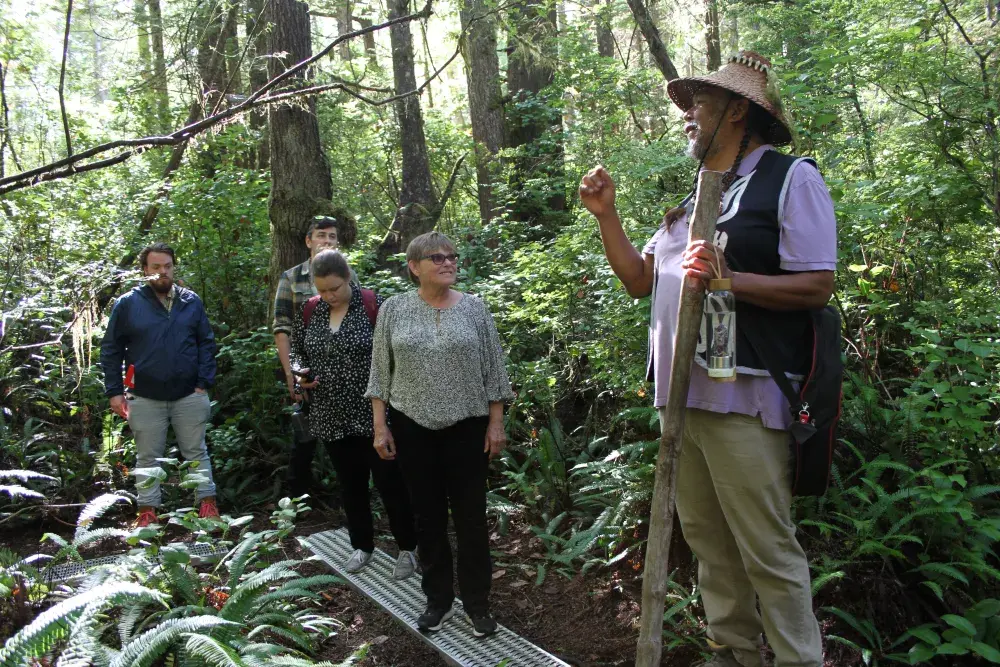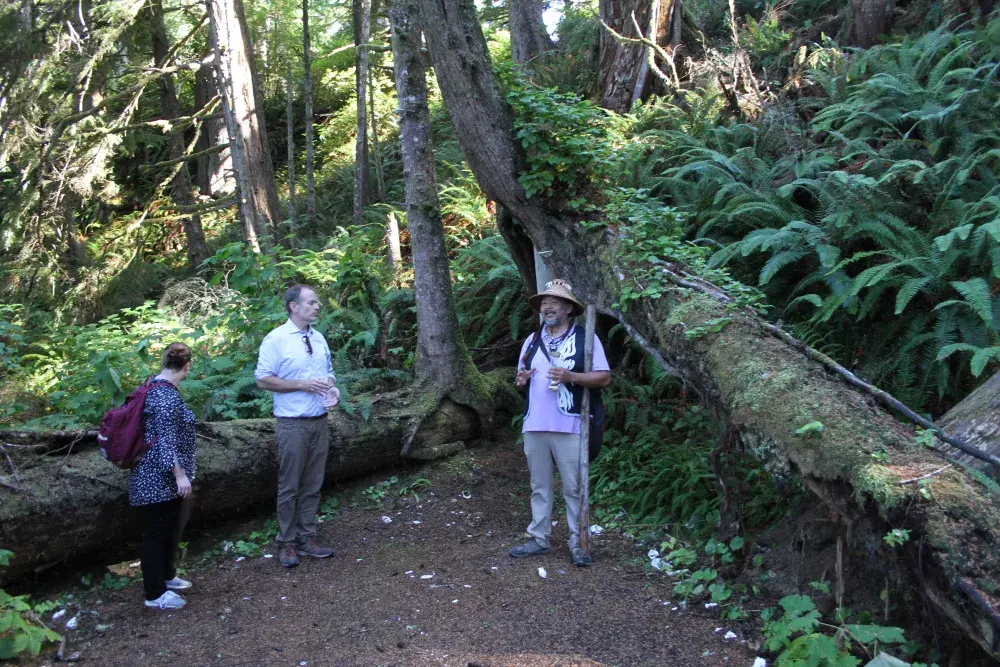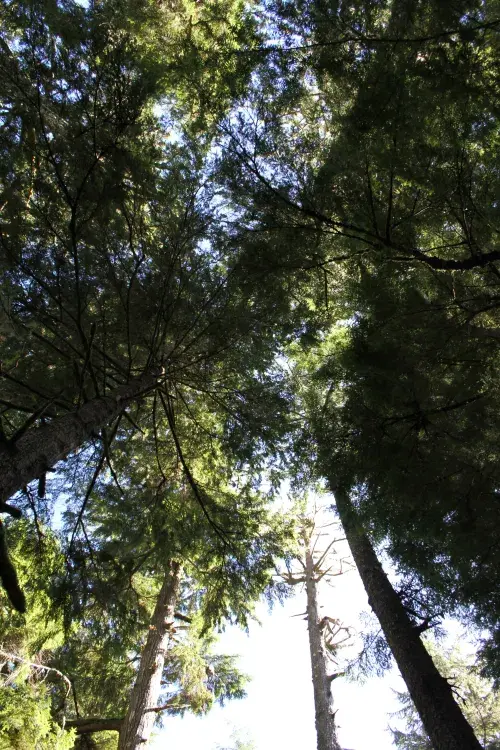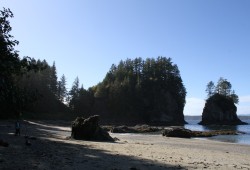As the First Nation looks to open up the area to more tourism, serious consideration is being given to extending the Trans Canada Trail to Huu-ay-aht territory on the southwest coast of Vancouver Island.
Spanning 28,000 kilometres by road, wilderness and waterway, the Trans Canada Trail is the longest network of recreational pathways in the world, extending to each of Canada’s three coasts. But currently just 566 kilometres of the trail is on Vancouver Island, running from Nanaimo to the Victoria area.
This could change if conversations continue about expanding the TCT to the island’s southwest coast. On Sept. 11 Eleanor McMahon, president and CEO of the Trans Canada Trail, visited Anacla and Bamfield, including a tour to the ancient Huu-ay-aht village and fortress site of Kiixin.
“This is an opportunity for us to amplify Indigenous trail tourism experiences, to tell the story and the origin story of Canada through that lens of Indigeneity, and amplify those important cultural stories,” said McMahon. “It’s an association with an iconic brand. We would be thrilled to have the opportunity to tell the story of Canada through the lens of the people here.”
McMahon’s visit developed from discussion with Courtenay-Alberni MP Gord Johns in April, who sees potential in the opportunity, as funding is available for First Nations that become part of the Trans Canada Trail. The TCT receives annual federal funding, as well as private donations.
“The experience of trail networks is invaluable,” said Johns, noting the marketing benefits of being part of the national trail. “It’s quite timely given the road completion coming.”
Currently the final stages are being undertaken to seal Bamfield Main, a multi-million-dollar investment from the province and the Huu-ay-aht to upgrade the 76-kilometre logging road from Port Alberni to Bamfield and the First Nation’s village of Anacla.
Cutting down on blinding summertime dust, wintertime washouts and suspension-busting potholes, the Bamfield Main upgrade is expected to enable regular vehicles to travel the road, thereby opening the remote area up to more visitors. The Trans Canada Trail could become a part of Huu-ay-aht’s future in the tourism industry, said Chief Councillor John Jack.
“It will be something that we put on the table before council. I do believe it will be seriously considered, given the natural overlapping interests that we see in the tourism industry, but also protecting natural sites and really diversifying into things like the Trans Canada Trail,” he said, noting that conversations with other First Nations on the coast will needed. “I do think that it’s going to take more than just one nation to make this happen, though.”
In June of last year the Indigenous presence along the Trans Canada Trail gained more exposure with the opening of Onhwa’ Lumina in Wendake. Located in the Quebec City area, where the Huron-Wedat Nation are based, the 1.2-kilometre Onhwa’ Lumina section incorporates a dynamically lit forest, with projections and animation that illustrate the myths and symbols of Wendake. To create the project Huron-Wendat members collaborated with Moment Factory, a Montreal-based multimedia entertainment company.
As many as 100,000 visitors were expected at Onhwa’ Lumina over the attraction’s first year. For the Trans Canada Trail, this serves as an indication of the tourism potential of Indigenous-led destinations. Earlier this year the TCT signed a memorandum of understanding with the Indigenous Tourism Association of Canada to continue moving partnerships forward.
“We would like more people to use our network, to become aware of it. We think it’s an amazing tool for tourism and economic development,” said McMahon, who saw trail use go up by 50 per cent during the pandemic - an engagement that has yet to show signs of declining. “The beauty and the wonder and the nature of Canada is an incredibly powerful draw for people around the world who want to connect to nature, and who live in populated countries.”
On Sept. 11 McMahon, Johns and other visitors where taken to Kiixin, an ancient Huu-ay-aht village site located on the coast near Bamfield and Anacla. A hike through old-growth forest reveals the National Historic Site of Canada, where soil deposits show evidence of 5,500 years of habitation, explained Qiic Qiica (pronouned Keets Keetsa) during the tour.
“The history of our country is relatively short, we only have 156 years as Canada, but in our village Kiixin we have 5,500 years,” he said. “This is an opportunity for us to not only share our culture with the world and fellow Canadians, but also our own people.”
Changes in the layers of soil show that at least 21 tsunamis hit Kiixin. As many as a dozen longhouses stood atop rocky bluffs at the site, enabling residents to watch for invaders. Ahousaht tribes invaded Kiixin multiple times, and Huu-ay-aht history tells of a family once hiding in a crevice within the rock bluff during an attack.
Some house posts are still evident at Kiixin, traces of multiple ages of habitation, the most recent dated in 1828.
“They all have a different time period. Sometimes they’re separated by decades, sometimes they’re separated by centuries,” explained Qiic Qiica. “As we’re getting ready to show this off to the world, we always like to remind our guests that there is a natural order, because we want to minimize our own footprint.”
Kiixin generated excitement among the guests, but Jack cautions that it’s unlikely the Huu-ay-aht would agree to including the site in the Trans Canada Trail.
“We have to take the appropriate measures to protect what needs to be protected, to channel a lot of the attention and energy into places that don’t necessarily have the same cumulative impacts as visiting the Kiixin site will,” said Jack. “There are locations adjacent to Kiixin that have significant potential for developing some sort of experience that’s more hands-on for individuals, and that Kiixin will remain a protected area, something that has very curated access and interaction.”
As Bamfield braces for more visitors, the elected chief looks to Tofino for lessons on preparing for the impacts of tourism in order to “maintain the unique character and experience” of Huu-ay-aht territory.
“Part of Tofino’s difficulty is that their constraining factors are geographic in nature, and that limits the amount of water that they have coming into their territory,” he said. “That may not necessarily be the same for our territory.”
Mid Island-Pacific Rim MLA Josie Osborne also attended the visit to Anacla and Bamfield, and now Eleanor McMahon plans to return to Vancouver Island in November, when she will visit the provincial legislature in Victoria to discuss the Trans Canada Trail with other MLAs.





